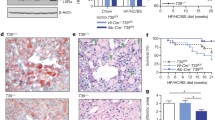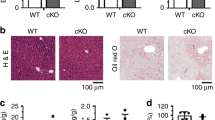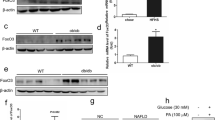Abstract
Liver fatty acid-binding protein (L-FABP, FABP1) is a highly conserved key factor in lipid metabolism. This study was undertaken to verify whether the T94A mutation in the L-FABP gene affects fatty acid uptake and intracellular esterification into specific lipid pools. Candidate SNPs were recreated using site-directed mutagenesis and tested for physical function in stably transfected Chang liver cell lines. We found that the T94A mutant of L-FABP lowered FFA uptake but had no effect on FFA efflux. L-FABP T94A-expressing cells showed decreased triglyceride content and increased cholesterol accumulation compared to the wild-type control for cells incubated with an FFA mixture (oleate: palmitate, 2:1 ratio). In conclusion, our study provided additional indications of the functional relevance of the L-FABP T94A SNP in hepatic fatty acid and lipid metabolism in humans.



Similar content being viewed by others
References
Chmurzynska A (2006) The multigene family of fatty acid-binding proteins (FABPs): function, structure and polymorphism. J Appl Genet 47:39–48
Ockner RK, Manning JA, Kane JP et al (1982) Fatty acid binding protein. Isolation from rat liver, characterization, and immunochemical quantification. J Biol Chem 257:7872–7878
Schachtrup C, Scholzen TE, Grau V et al (2004) L-FABP is exclusively expressed in alveolar macrophages within the myeloid lineage: evidence for a PPARalpha-independent expression. Int J Biochem Cell Biol 36:2042–2053. doi:10.1016/j.biocel.2004.03.008
Yamamoto T, Noiri E, Ono Y et al (2007) Renal L-type fatty acid–binding protein in acute ischemic injury. J Am Soc Nephrol 18:2894–2902. doi:10.1681/ASN.2007010097
Neeli I, Siddiqi SA, Siddiqi S, Mansbach CM II et al (2007) Liver fatty acid-binding protein initiates budding of pre-chylomicron transport vesicles from intestinal endoplasmic reticulum. J Biol Chem 282:17974–17984. doi:10.1074/jbc.M610765200
McArthur MJ, Atshaves BP, Frolov A et al (1999) Cellular uptake and intracellular trafficking of long chain fatty acids. J Lipid Res 40:1371–1383
Dietrich A, Dieminger W, Fuchte K et al (1995) Functional significance of interaction of H-FABP with sulfated and nonsulfated taurine-conjugated bile salts in rat liver. J Lipid Res 36:1745–1755
Thumser AE, Wilton DC (1996) The binding of cholesterol and bile salts to recombinant rat liver fatty acid-binding protein. Biochem J 320:729–733
Wolfrum C, Buhlmann C, Rolf B et al (1999) Variation of liver-type fatty acid binding protein content in the human hepatoma cell line HepG2 by peroxisome proliferators and antisense RNA affects the rate of fatty acid uptake. Biochim Biophys Acta 1437:194–201
Murphy EJ, Prows DR, Jefferson JR et al (1996) Liver fatty acid-binding protein expression in transfected fibroblasts stimulates fatty acid uptake and metabolism. Biochim Biophys Acta 1301:191–198
Martin GG, Danneberg H, Kumar LS et al (2003) Decreased liver fatty acid binding capacity and altered liver lipid distribution in mice lacking the liver fatty acid-binding protein gene. J Biol Chem 278:21429–21438. doi:10.1074/jbc.M300287200
Newberry EP, Xie Y, Kennedy SM et al (2003) Decreased hepatic triglyceride accumulation and altered fatty acid uptake in mice with deletion of the liver fatty acid-binding protein gene. J Biol Chem 278:51664–51672. doi:10.1074/jbc.M309377200
Newberry EP, Xie Y, Kennedy SM, Davidson NO et al (2006) Protection against Western diet-induced obesity and hepatic steatosis in liver fatty acid-binding protein knockout mice. Hepatology 44:1191–1205. doi:10.1002/hep.21369
Newberry EP, Kennedy SM, Xie Y et al (2008) Diet-induced obesity and hepatic steatosis in L-Fabp -/- mice is abrogated with SF, but not PUFA, feeding and attenuated after cholesterol supplementation. Am J Physiol Gastrointest Liver Physiol 294:G307–G314. doi:10.1152/ajpgi.00377.2007
Brouillette C, Bossé Y, Pérusse L et al (2004) Effect of liver fatty acid binding protein (FABP) T94A missense mutation on plasma lipoprotein responsiveness to treatment with fenofibrate. J Hum Genet 49:424–432. doi:10.1007/s10038-004-0171-2
Thompson J, Winter N, Terwey D et al (1997) The crystal structure of the liver fatty acid-binding protein. A complex with two bound oleates. J Biol Chem 272:7140–7150. doi:10.1074/jbc.272.11.7140
Fisher E, Weikert C, Klapper M et al (2007) L-FABP T94A is associated with fasting triglycerides and LDL-cholesterol in women. Mol Genet Metab 91:278–284. doi:10.1016/j.ymgme.2007.03.002
Robitaille J, Brouillette C, Lemieux S et al (2004) Plasma concentrations of apolipoprotein B are modulated by a gene–diet interaction effect between the LFABP T94A polymorphism and dietary fat intake in French-Canadian men. Mol Genet Metab 82:296–303. doi:10.1016/j.ymgme.2004.06.002
Atshaves BP, McIntosh AM, Lyuksyutova OI et al (2004) Liver fatty acid-binding protein gene ablation inhibits branched-chain fatty acid metabolism in cultured primary hepatocytes. J Biol Chem 279:30954–30965. doi:10.1074/jbc.M313571200
Wang G, Gong Y, Anderson J, Sun D et al (2005) Antioxidative function of L-FABP in L-FABP stably transfected Chang liver cells. Hepatology 42:871–879. doi:10.1002/hep.20857
Cousin SP, Hügl SR, Wrede CE et al (2001) Free fatty acid-induced inhibition of glucose and insulin-like growth factor I-induced deoxyribonucleic acid synthesis in the pancreatic beta-cell line INS-1. Endocrinology 142:229–240
Linden D, Lindberg K, Oscarsson J et al (2002) Influence of peroxisome proliferator-activated receptor alpha agonists on the intracellular turnover and secretion of apolipoprotein (Apo) B-100 and ApoB-48. J Biol Chem 277:23044–23053. doi:10.1074/jbc.M110416200
Weickert MO, Loeffelholz CV, Roden M et al (2007) Thr94Ala mutation in human liver fatty acid-binding protein contributes to reduced hepatic glycogenolysis and blunted elevation of plasma glucose levels in lipid-exposed subjects. Am J Physiol Endocrinol Metab 293:E1078–E1084. doi:10.1152/ajpendo.00337.2007
Newberry EP, Kennedy SM, Xie Y et al (2009) Diet-induced alterations in intestinal and extrahepatic lipid metabolism in liver fatty acid binding protein knockout mice. Mol Cell Biochem 326:79–86. doi:10.1007/s11010-008-0002-4
Acknowledgments
This study was supported by the National Undergraduate Student Innovation Experimental Design Project (YA07048) and the Hunan Province Science and Technology Plan (2007FG3035).
Conflict of interest
The authors report no conflicts of interest regarding this study.
Author information
Authors and Affiliations
Corresponding author
Rights and permissions
About this article
Cite this article
Gao, N., Qu, X., Yan, J. et al. L-FABP T94A decreased fatty acid uptake and altered hepatic triglyceride and cholesterol accumulation in Chang liver cells stably transfected with L-FABP. Mol Cell Biochem 345, 207–214 (2010). https://doi.org/10.1007/s11010-010-0574-7
Received:
Accepted:
Published:
Issue Date:
DOI: https://doi.org/10.1007/s11010-010-0574-7




